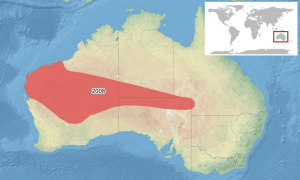Spencer's burrowing frog facts for kids
Quick facts for kids Spencer's burrowing frog |
|
|---|---|
 |
|
| Conservation status | |
| Scientific classification | |
| Genus: |
Opisthodon
|
| Species: |
spenceri
|
 |
|
| Synonyms | |
|
Limnodynastes spenceri |
|
The Spencer's burrowing frog (Opisthodon spenceri) is a special type of frog. It lives in the western and central parts of Australia. This frog was once known by a different name, Limnodynastes spenceri.
Contents
What Does Spencer's Burrowing Frog Look Like?
Spencer's burrowing frog is quite similar to another frog called the ornate burrowing frog. Both are part of the same group, Opisthodon.
This frog is short and round, almost like a little ball. It has a small head but big eyes. Its skin can be many different colors and patterns. You might see them in dark brown or light grey. They often have darker blotches on their back. Sometimes, there's a dark, butterfly-shaped patch behind their eyes.
Their legs and arms usually have stripes or spots. You can't easily see their eardrum, called the tympanum. Their feet can have some webbing or be fully webbed. However, the lack of full webbing helps them dig into the ground easily.
Where Do Spencer's Burrowing Frogs Live?
Spencer's burrowing frogs are known as fossorial animals. This means they spend a lot of their time digging and living underground. They are perfectly suited for the desert areas of western and central Australia.
They like to live in sandy creeks and rivers. Being underground helps them stay safe and cool. It also protects them from drying out during very hot and dry times.
How Do Spencer's Burrowing Frogs Behave?
These frogs are very good at surviving in dry places. When there's no rain, they dig deep into the ground. They stay there, safe from the heat, until the weather changes.
After a lot of rain, the frogs come out of their underground homes. This is when they look for food. It's also when they find a mate to have babies.
Life Cycle and Reproduction
Male Spencer's burrowing frogs will call out near water sources. Their call sounds like a fast "hoh-hoh-hoh." This helps them attract females.
The female frog lays her eggs in a special foam. This foam floats on top of the water. After about a day, the foam breaks down. This releases the eggs into the water.
The eggs quickly hatch into tadpoles. These tadpoles develop very fast. They can turn into tiny frogs in just 60 days. This quick growth is important. It helps them change before the temporary pools of water dry up.
See also
 In Spanish: Platyplectrum spenceri para niños
In Spanish: Platyplectrum spenceri para niños


